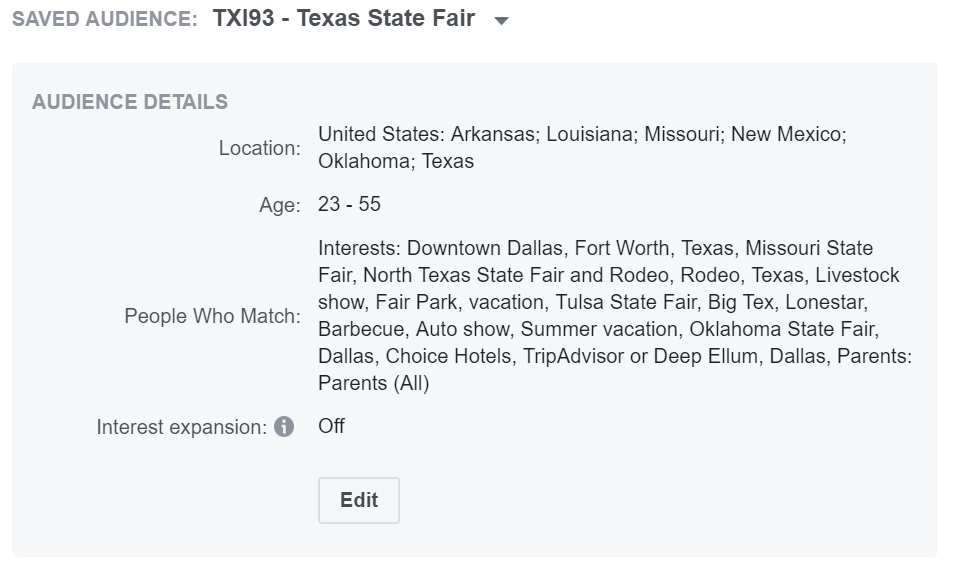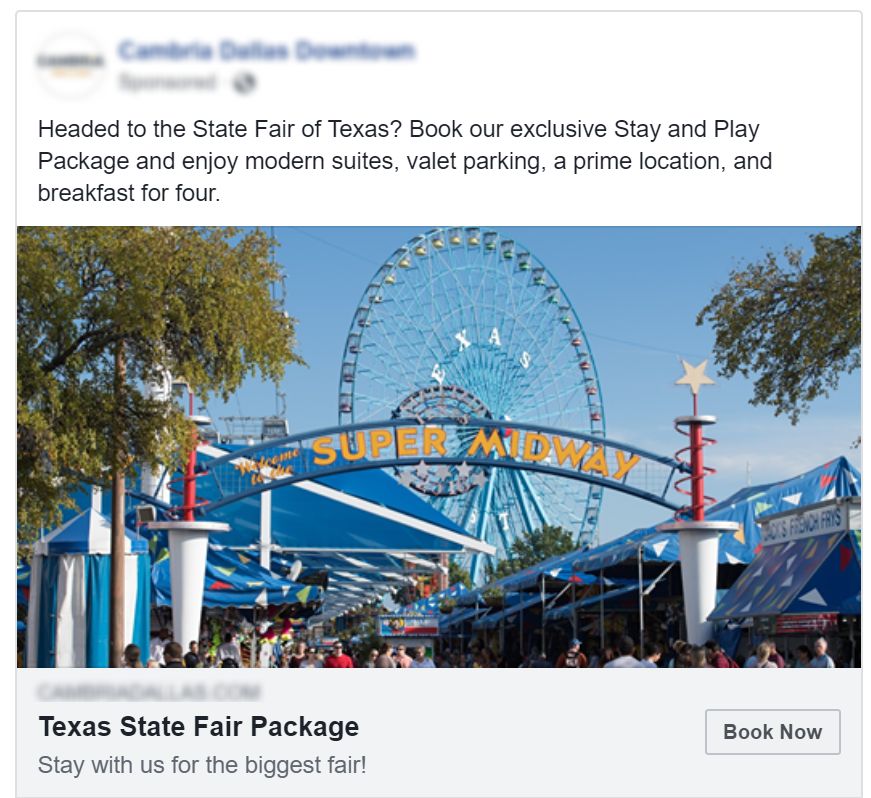Targeted Facebook ad campaigns can be a great source of revenue for your hotel, especially if you take advantage of big events in your local area by offering guests a special package to entice them to book. Not only do campaigns increase social media visibility, but they can also increase website traffic, and most importantly, drive revenue. By adhering to a few key practices and honing in on your strategy, you can use paid social to reach your hotel’s goals. Follow the steps our social media experts took to help one of our clients run a successful paid social campaign.
Establish a Goal for the Ad Campaign
It is important to first determine a goal for your campaign. Do you want to gain more followers on your Facebook Page? Do you want to see more engagement on a post? In this particular example, our client’s goal was to promote a special package they created for the State Fair of Texas. To do this, we directed traffic to the destination page of their website where more information about the package and booking options could be found. Utilizing a targeted Facebook campaign to promote this package was an excellent choice, as the State Fair of Texas draws over 2 million visitors annually and is located just minutes from the hotel, making the package even more enticing for potential guests.
Choose Your Audience
Next, we had to decide who we wanted to target for this campaign. Specific targeting helps ensure your Facebook ads are seen by the right people who are more likely to take action. Facebook offers a wide range of targeting options, such as interests, demographics, and locations to incorporate into your campaign strategy. Sometimes you are lucky enough to have demographic studies available to you, but most of the time you need to research the event, the area, and your hotel’s needs in order to determine the best course for targeting. In this case, we had a mixture of both. Eventcorp Services gathered attendee stats from 2017’s State Fair of Texas and made it accessible to the public. Using this in combination with information we gathered from the client and our own research efforts, we decided to target Texas and its surrounding states, men and women ages 23 to 55, and specific interests that were relevant to the event.

Choose Your Creative Assets for the Facebook Ad Campaign
A picture is worth a thousand words, especially when you have a limited amount of space for copy in ads. It is crucial that your image is not only relevant to your campaign, but also to your target audience, as you do not want a potential guest to scroll past your ad. For this campaign, we chose three photos from the fair to entice guests.

We created two versions of copy so that we had six different versions of our ad to test. Building multiple versions of an ad to run in tandem with each other is known as A/B testing and is an important step to determine which ads will be most effective and gain the most return.
Monitor and Adjust Your Campaign
You must watch your campaign closely from start to finish as some underperforming ads may need to be turned off, targeting may need to be modified, or errors may occur during delivery. Any number of things can happen between your campaign start and end date, so check in every other day, if not more, to ensure success. Since we published six different ads for this campaign, it was vital that we paid attention to which ads were underperforming. As you can see here, two were left active.

What should you look for when determining an underperforming ad? These are the stats you should monitor when determining which ads to keep and which to drop:
- Relevancy Score: A relevancy score ranging from 1 to 10 is given by Facebook for each ad. The lower the score, the more it will cost to deliver the ad and the less it will be seen by your audience.
- Link Clicks: The number of clicks on links within the ad.
- Reach: The number of people who saw the ads at least once.
- Cost Per Result: How much of your budget is spent per action.
- Frequency: The average number of times each person saw the ad.
Make sure you give your ads some time to run. A week is generally a good standard, but once your ads receive a relevancy score you should start making decisions. Turn off ads that have the highest cost per result, as well as ads with low link clicks, relevancy scores, or reach. That way you can focus on the most effective ads to serve to your audience as well as minimize cost.
Explore the Results
The best part of a Facebook ad campaign is seeing your hard work rewarded with optimal results. After one month and a budget of only $500, our campaign received a total of 2,667 link clicks to the client’s website, a reach of 96,298, and a cost of only $0.19 per link click.
![]()
We then took a look at Google Analytics, an important step if your goal is to drive traffic to your website. Below you can see guests not only clicked on the ad link, but also took the next step to check rate. We reported 371 guests checked rate.

What makes these results great? Imagine that 1 out of every 25 people who checked rate booked the package at the lowest ADR and stayed a minimum of one night. That’s a $5 to $1 ROI! In addition to generating revenue, this campaign lead to 40 new Facebook followers and over 2,500-page engagements for the client.
Let’s Recap
To ensure a successful Facebook campaign remember to:
- Establish a clear goal for your campaign
- Choose your audience wisely
- Select relevant and eye-catching creatives
- Monitor and adjust your campaign throughout its delivery
- Record and compare the results of your campaign
- Celebrate your success!
As always, the Blue Magnet team is here to help and ensure you have a winning social media campaign. Check out our social media services to learn how we can take your social media marketing strategy to the next level!




